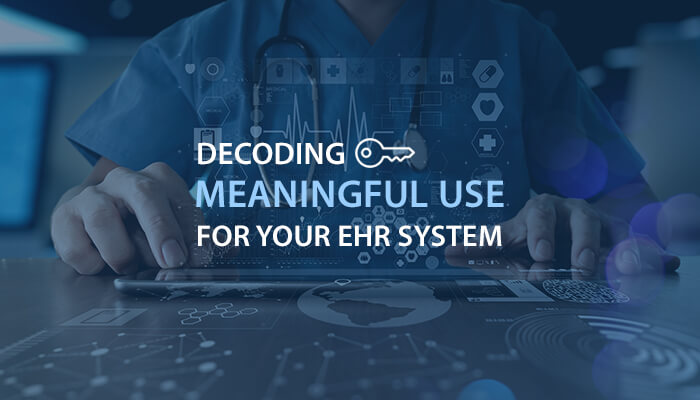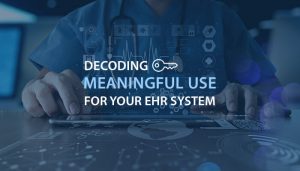Decoding Meaningful Use For Your EHR System

Decoding Meaningful Use will improve implementation and optimization of an electronic health records system.
During EHR implementation, it can become confusing to successfully navigate federal and locally-mandated requirements for regulations concerning HIPAA and Meaningful Use. For many healthcare practices, Meaningful Use attestation has become less of a collaboration in good patient care, and more of a headache – but it doesn’t have to be.
Decoding Meaningful Use and understanding its requirements will not only improve implementation and optimization of an electronic health records system, but it will also result in improved clinical processes, and ultimately, better patient outcomes.
What is Meaningful Use?
Back in 2009, Meaningful Use was developed by the federal government as a way to regulate electronic health records systems, and ensure that providers are on track to make the most out of those systems. Their incentive programs for Medicare & Medicaid generated incredible interest, and within just a few years, had captured most of the US industry. Last year, the ONC reported that of Critical Access and other eligible hospitals, 95 percent had demonstrated Meaningful Use. Meanwhile, according to CMS, over half a million providers had received over $25 billion in federal payments through the Medicare & Medicaid incentive programs as of this summer.
But this brings up an important question: just who benefits from Meaningful Use? The answer is encouraging. When employed properly, Meaningful Use benefits everybody. Providers and their staff benefit from improved clinical processes, billing and insurance parties benefit from standardization, and patients benefit from better care.
Understanding Meaningful Use Incentive Programs
The role of federal incentives is simply to encourage providers to adhere to Meaningful Use requirements through certified EHR systems. Finding vendors that provide certified EHR technology is critical to qualifying for these incentive programs, which have to-date paid tens of billions to providers who have successfully met the requirements of the incentive programs. Not only are these programs designed to improve health outcomes through compliance with important measures, but also encourage certified EHR adoption through effectively lowering the cost of EHR implementation for healthcare organizations.
The Future of Meaningful Use and EHRs
Each year, CMS and the ONC release new updates for Meaningful Use. Currently, the incentive programs have been widely successful, with over 500,000 medical practices having attested for Meaningful Use as of this year. And moving forward, there is still a great deal of opportunity for benefit to both providers and their patients.
There will still be significant pressure from the federal government to achieve even more universal adherence to Meaningful Use. Many of the most ambitious goals of the program can only be achieved through near-universal participation including those regarding information exchange. For Medicaid, 2016 represents the final year of beginning participation in the incentive program. And while CMS’ final rule published in 2015 extended through to 2017, the Center for Medicare & Medicaid Services has already begun constructing their 2017 requirements.
Successfully attesting for Meaningful Use isn’t always easy. That’s why it’s crucial to find an EHR vendor that is ready to support you and your practice every step of the way towards successful implementation.
At ZH Healthcare, our certified technology blueEHR is built to benefit both the provider and the patient with close adherence to Meaningful Use requirements. Not only can we help you achieve improved outcomes through meeting and exceeding federal requirements, but we’ll be there at every step to help you successfully attest for Meaningful Use.
Contact us to learn more today, and discover how we take the guesswork out of regulatory requirements.

